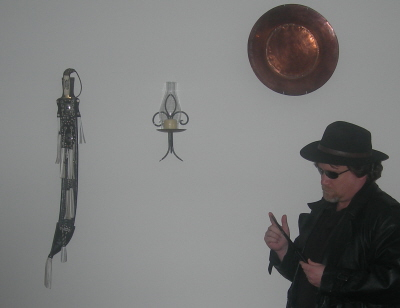|
About This Author
Come closer.
|
Complex Numbers
Complex Numbers
A complex number is expressed in the standard form a + bi, where a and b are real numbers and i is defined by i^2 = -1 (that is, i is the square root of -1). For example, 3 + 2i is a complex number.
The bi term is often referred to as an imaginary number (though this may be misleading, as it is no more "imaginary" than the symbolic abstractions we know as the "real" numbers). Thus, every complex number has a real part, a, and an imaginary part, bi.
Complex numbers are often represented on a graph known as the "complex plane," where the horizontal axis represents the infinity of real numbers, and the vertical axis represents the infinity of imaginary numbers. Thus, each complex number has a unique representation on the complex plane: some closer to real; others, more imaginary. If a = b, the number is equal parts real and imaginary.
Very simple transformations applied to numbers in the complex plane can lead to fractal structures of enormous intricacy and astonishing beauty.
November 27, 2023 at 9:16am November 27, 2023 at 9:16am
| |
Here's a link from a source I don't think I've ever featured before, The Collector.
Ancient Western authors, so the list was necessarily limited in geographical scope.
I'm going to abbreviate them as SWAW sometimes, because I'm lazy.
The Seven Wonders of the Ancient World were a collection of buildings admired as feats of beauty and human engineering.
"Human engineering" could mean two different things; in this case, probably "engineered by humans" rather than "making it so humans do what you want them to do."
The list includes the Great Pyramid of Giza, the Mausoleum at Halicarnassus, the Temple of Artemis in Ephesus, the Statue of Zeus from Olympia, the Colossus of Rhodes, Alexandria’s Pharos or Great Lighthouse, and the Hanging Gardens of Babylon.
I think it's also important to note that "ancient authors" made little distinction between fiction and truth, much like postmodernists today. If some old Greek dude said that there was a giant statue of Dionysus straddling the strait between Italy and Sicily, that needs to be backed up by archaeological evidence, or at least a couple more primary sources.
Pretty sure most of these are thus confirmed. Most.
1. The Great Pyramid of Giza: The Only Ancient Wonder Still Standing
One advantage of a pyramid is low center of gravity: hard to topple. Still, the pyramids are pale shadows of their original forms.
The Pyramids are the crowning glory of the Giza Necropolis and originally gleamed in shining white limestone with golden capstones. They served as tombs for the Pharaohs and were invested with intense religious symbolism, although the exact nature of that symbolism still divides scholars, and acted as a statement of the Pharaoh’s power over the materials and manpower needed to create them.
This uncertainty has led to all manner of wild-ass speculation, most of which has no basis in reality. Perhaps the worst such speculation is that aliens built them, because some people seem to have to believe that humans aren't capable of such feats.
2. Mausoleum of Halicarnassus
This is the one I always forget when someone pop-quizzes me on the SWAW. Probably because "Halicarnassus" is a mouthful.
The Mausoleum of Halicarnassus was built at the city of Halicarnassus on the Western coast of modern-day Turkey in the mid-4th century BCE for the Carian king Mausolus and his family.
Oh... so that's the etymology of "mausoleum."
As will become a trend with the wonders, we do not actually know how it fell to ruin. It was still standing in the Roman period, but at some point in the following millennium it fell into disrepair. No sources describe how or why this happened.
Entropy wins. Entropy always wins.
3. The Temple of Artemis at Ephesus
Artemis was the Greek goddess of the hunt and had strong associations with the moon and female youth, which earned her high regard across the Greek world.
The lunar association came later, I think.
The Temple of Artemis was actually three temples built and destroyed at separate times. The date of the construction of the first temple is unknown, but we do know that it was destroyed by a flood in the 7th century BCE. It was rebuilt larger with slight design changes soon after, only to burn down in 356 BCE due to arson by a man named Herostratus.
Calls to mind Swamp Castle from Monty Python and the Holy Grail.
You'd think that they'd learn something from repeated destruction of a temple. Possible lessons:
a) the gods exist but don't care;
b) the gods exist and hate temples being built to them; or
c) the gods don't exist.
In any of those cases, why build temples and such?
This was around the time of the birth of Alexander the Great in Macedonia and Plutarch relates one story that said the temple burned because the gods were distracted by his arrival into the world.
But no, we just continue to make up stories and reasons.
4. Statue of Zeus at Olympia
From the drawing of this in the article, it seems like this was the main inspiration for the marble Lincoln in Washington, DC.
The statue was made of wood covered in gold and ivory plates and stood at 14m tall, although it must be noted that Zeus was seated on a similarly massive throne, so the figure itself was considerably larger than the height suggests.
"We don't have the budget for a solid gold statue. You think Zeus would notice if we used gold-plated wood?"
It’s as if the Statue of Zeus simply faded away into history and historians are still at a loss over what became of it.
Metaphor!
5. Colossus of Rhodes
I'm not certain if this was the explicit inspiration for the Statue of Liberty in New York Harbor, but Emma Lazarus made the connection.
This was a massive 33m tall bronze statue of the traditional Greek god of the sun and patron of Rhodes, Helios, which towered over the harbor of the maritime nation.
People like to compare the heights of everything to said Statue of Liberty (yes, I know that's not its official name), which is 46 meters, plinth to torch. While it's not surprising that an industrial-age construct could be bigger than one in ancient Greece, well, like I said, just making the comparison.
In 226 BCE, just 54 years after its completion, a devastating earthquake sent the Colossus toppling to the ground. Despite being offered help to rebuild it by the Ptolemies of Egypt, Rhodes interpreted its destruction as a sign of divine disfavor and never repaired it.
See? Rhodes (a tiny island in the Mediterranean) figured it out.
Like the other ancient wonders, there was no definitive final moment, but a slow death as the once-great icon of Rhodes became too unimportant to even warrant a clear record of its fate.
Another metaphor!
6. Lighthouse of Alexandria (Pharos)
Situated on the island of Pharos, which is also the ancient name of the lighthouse, it was perfectly placed to serve Alexandria’s bustling maritime industry.
The French translation of "lighthouse" is Phare, which apparently traces its origin to Pharos. What's not clear to me is if there's a linguistic connection between Phare/Pharos and Pharaoh. The latter is usually translated as "great house," so... maybe? I can't be arsed to look into it further today.
The soaring 100m tall structure...
So, just over two Statues of Liberty.
It was one of several incredible monuments that defined the city, including the famous Library of Alexandria and the Tomb of Alexander the Great.
Still salty about the destruction of the former. As for the latter, well, one shouldn't treat Marvel's Moon Knight as historically accurate.
7. The Hanging Gardens of Babylon
Remember I said something up there about having to be supported by archaeological evidence?
Lastly, we have the most challenging wonder of all: the Hanging Gardens of Babylon. Why are they a challenge? Because they might never have existed in the first place.
The article explains this in further detail.
Therefore, we cannot say anything concrete about the Gardens or what befell them.
Get it? Concrete?
Babylon’s fall from a mighty ancient city to an insignificant village so minor that its location was considered lost for centuries echoes the same theme as the fate of the other wonders: no matter how wonderful, elaborate, or famous something is, time will lay it low.
Ozymandias nods knowingly.
Attempts have been made over the intervening centuries to compile new Seven Wonders, because seven is, I don't know, numerologically significant? Or at least historically.
We'll see if any last as long as the Pyramids (sort of) have. |
© Copyright 2025 Robert Waltz (UN: cathartes02 at Writing.Com). All rights reserved.
Robert Waltz has granted InkSpot.Com, its affiliates and its syndicates non-exclusive rights to display this work.
|

